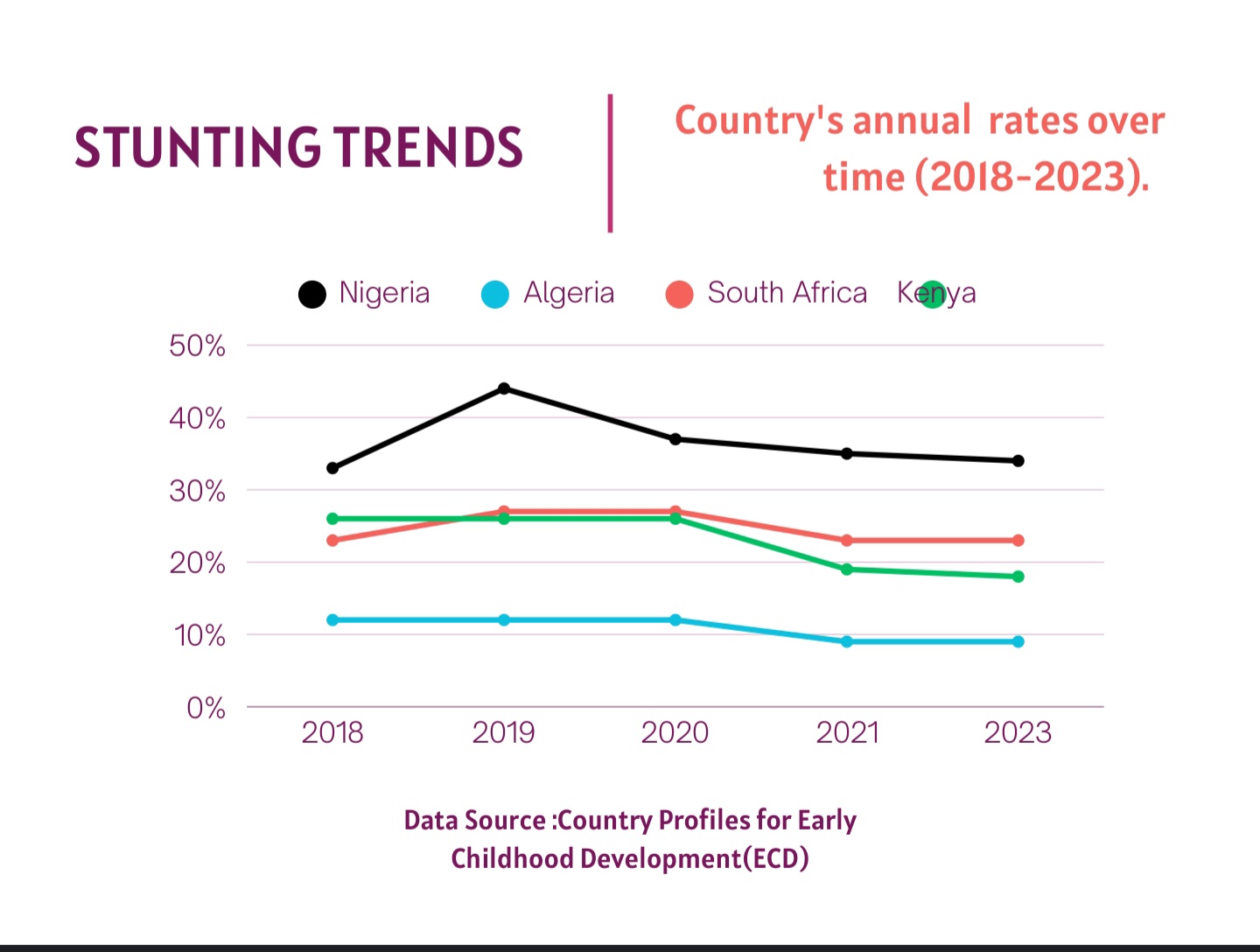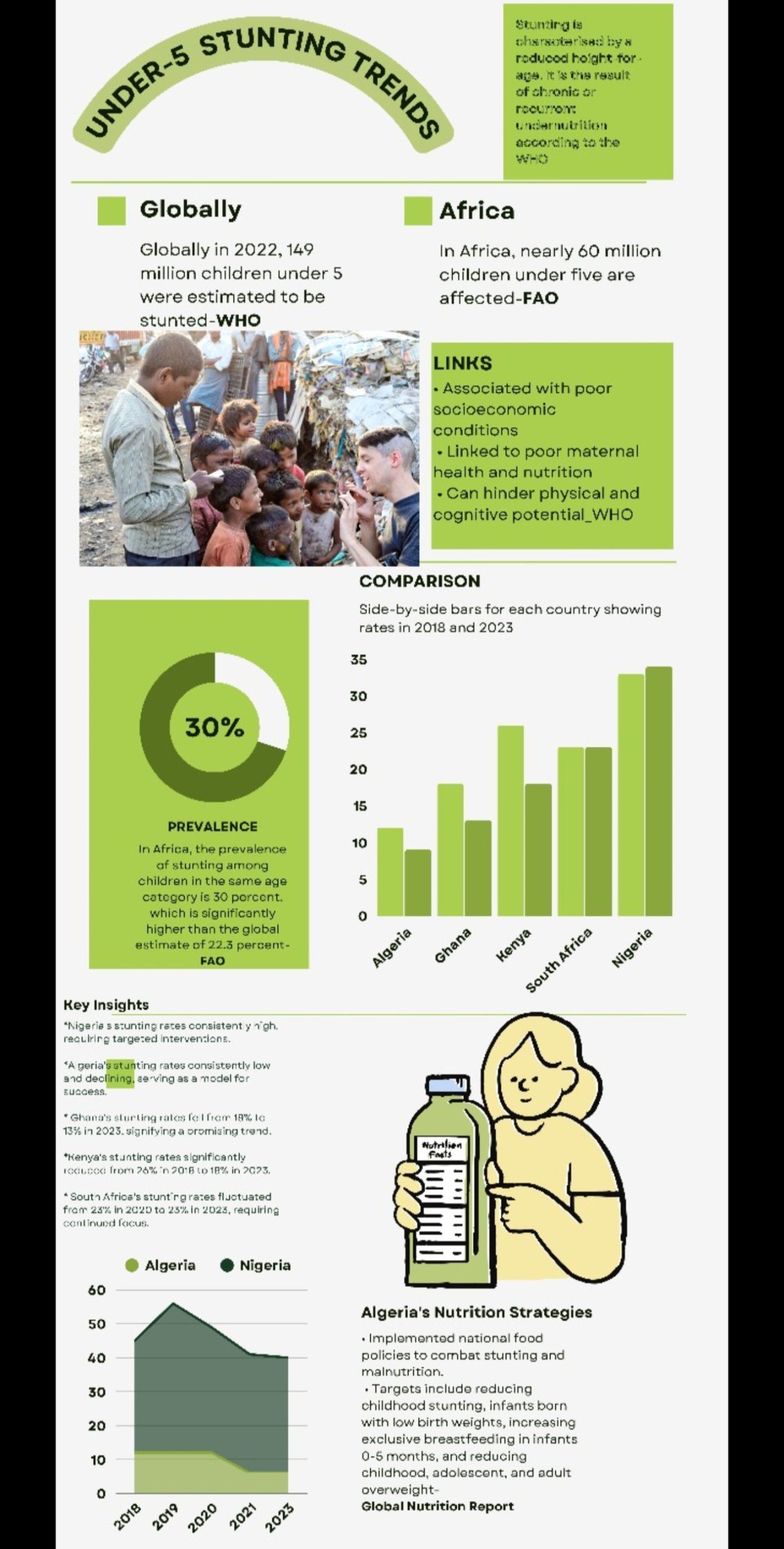By Rakiya A.Muhammad
Across the world, millions of children suffer from stunting— which the World Health Organisation describes as the impaired growth and development that children experience from poor nutrition, repeated infection, and inadequate psychosocial stimulation.
Globally, over one in five children (148.1 million) under five years of age were stunted in 2022, according to the African Regional Overview of Food Security and Nutrition.
”In Africa, the prevalence of stunting among children in the same age category is 30 percent, which is significantly higher than the global estimate of 22.3 percent.”
A Continent’s Disparate Rates
Data from the ‘Country Profiles for Early Childhood Development,’ created by UNICEF in partnership with Countdown to 2030 Women’s, Children’s, and Adolescent’s Health, indicate disparate stunting rates across several African countries from 2018 to 2023.
While certain policies are in place in countries to combat stunting, progress varies significantly; for example, South Africa’s numbers fluctuate, rising from 23% in 2018 to 27% in 2019 and 2020, then falling to 23% in 2021 and remaining at 23% in 2023.
Algeria, on the other hand, has maintained low stunting rates, which have fallen from around 12% in 2018 to 9% in 2023.
Similarly, Ghana has reduced its stunting rate from 24% in 2018 to 15% in 2023, while Kenya has reduced stunting from 26% in 2018 to 18% in 2023.
But in Nigeria the narrative takes a dramatic turn, recording 33% rate in 2018,44% in 2019, 37% in 2020, 35% in 2021 and 34% in 2023.
The Nigerian Chronicle
In Nigeria, the under-five stunting rate remains high, peaking at 44% in 2019.
What caused the sudden surge in 2019? Is the economy in turmoil? Conflict? Is it election year? Or maybe a health crisis? The truth is intricately intertwined into the fabric of societal difficulties.
Emir Muhammadu Sanusi II in his capacity as the Chairman of the Board of Trustees of the Nutrition Society of Nigerian speaks to the dire situation, during a presentation to the National Economic Council ‘s first meeting of the year in January 2020.
“Over twelve (12) million children are stunted in Nigeria while 2.6 million are wasted annually due to malnutrition,” he notes adding that malnutrition accounted for 53% of deaths among children.
Nigeria, he adds, recorded the highest number of stunted children in Africa, highlighting poverty, socio-cultural issues, and the political environment as key factors
Today, Nigeria’s rates have slightly declined, but the scars of past fluctuations remain.
After the 2019 spike, there’s a gradual decline from 37% in 2020 to 35% in 2021 and 34% in 2023, but rates remain above 33% statistics of 2018, reflecting ongoing systemic challenges.

Mrs. Ladidi Bako-Aiyebusi, the Director of the Nutrition Department at the Federal Ministry of Health and Social Welfare, articulates the nation’s struggle with a “triple burden” of malnutrition. She notes the multifaceted dilemma encompasses alarming deficiencies in both macro and micronutrients, alongside the dual challenges of undernutrition and over-nutrition. The roots of this crisis, she adds, are tangled in a web of limited food access, poor feeding practices, and pervasive socio-economic issues that plague the country.
Echoing these concerns, Ms. Cristian Munduate, the UNICEF Representative in Nigeria, emphasizes the profound implications of malnutrition on children’s development. She warns that severe stunting during the critical first five years of life can irreversibly impair cognitive and intellectual growth, a fate that cannot be undone even with later nutritional interventions.
“The problem with this is these children are not only affected by their weight, their height, but when you have severe stunting, your brain doesn’t develop well in the first five years of life,” she points out.
“This is irreversible. It doesn’t matter if later on, you feed the child properly or the child is not stunted. Once your cognitive and intellectual capacities are affected, it is very difficult to turn back.”
Munduate underscores the urgency of taking early life-saving actions to address stunting. “The first 1000 days are important because if you have poor nutrition during the first thousand days, this causes irreversible physical and cognitive problems in the child’s body.”
She notes that the first challenge children face in terms of food insecurity is widespread poverty, a situation she observes, is exacerbated by rising poverty levels over the past two years.
“So, at this moment, what we have is that two out of three children in Nigeria experience food poverty. This food poverty comes along with lacking of diverse nutrients that are essential for growth. So, families do not have the necessary income to feed their children properly,” she highlights
Moreover, she adds that the concept of multi-dimensional poverty reveals a deeper vulnerability among households, particularly affecting children who are deprived not only of nutrition but also of health and sanitation “This is because it is a lack of nutrition, lack of health, and lack of sanitation, which in the end affects your capacity and hinders your opportunities for life and growth.”
However, in a resolute move, Hon. Tajudeen Abbas, the Speaker of the House of Representatives, conveys a powerful commitment to combat the pressing issues of food insecurity and malnutrition plaguing Nigeria. In a recent inauguration of the House Committee on Nutrition and Food Security, he underlines the committee’s pivotal role in shaping legislative measures aimed at alleviating the hunger crisis exacerbated by climate change, inflation, and widespread insecurity.
Abbas paints a stark picture of the current food crisis, revealing alarming statistics from the UN Office for the Coordination of Humanitarian Affairs, which forecast that 26.5 million Nigerians will face severe food insecurity in 2024. He highlights the nation’s troubling status as the second highest in global malnutrition rates, with over 30% of children under five suffering from stunting or chronic malnourishment. The statistics further revealed that 35 million children are affected by malnutrition, with millions experiencing severe acute conditions.

The Speaker emphasizes the urgency of legislative action in light of these grim realities, attributing the crisis to a combination of factors including climate change, insecurity disrupting agricultural activities, and outdated farming practices. He calls upon the newly formed committee to take decisive steps in addressing these challenges through effective oversight and the development of new legislative frameworks that support agricultural production and food supply chains.
The commitment, he asserts, is essential not only for tackling immediate hunger and malnutrition but also for fostering sustainable development and reducing poverty across the nation.
Nigeria’s Coordinating Minister of Health and Social Welfare, Ali Pate, is implementing a multi-sectoral approach to combat malnutrition, utilizing local, ready-to-use therapeutic foods.
The federal government has set aside $11 billion and UNICEF has contributed an extra $60 million to bolster healthcare infrastructure and nutrition programs.
The intricate web of socioeconomic factors fuelling this crisis calls for a united front among all stakeholders in the battle against stunting and various manifestations of malnutrition.
The Algerian Example
According to the Global Nutrition Report, Algeria has made some progress towards achieving the target for stunting, but 9.8% of children under 5 years of age are still affected, which is lower than the average for the Africa region (30.7%).
“Algeria is ‘on course’ for the target for wasting, with 2.7% of children under 5 years of age affected, which is lower than the average for the Africa region (6.0%),” it adds. “The prevalence of overweight children under 5 years of age is 12.8% and Algeria is ‘on course’ to prevent the figure from increasing.”
The North African country has taken steps to address stunting and other forms of malnutrition through its national food policies. These policies have goals that align with the global nutrition target, such as: Reducing childhood stunting, Reducing the number of infants born with low birth weights, Increasing the prevalence of exclusive breastfeeding in infants 0-5 months, Reducing childhood, adolescent, and adult overweight.
Stemming Global Tide
In a world where millions grapple with some form of malnutrition, the urgency to combat food insecurity and implement food systems strategies that enhance health outcomes has never been more pronounced.
Francesco Branca, the Director of Nutrition for Health and Development at the World Health Organisation expresses WHO’s commitment to supporting governments and their stakeholders to investigate the intersections between health and food systems, and to take food systems actions that impact health in a positive way, nationally, regionally, and globally.
“We are all members of the global food system, and we all have a responsibility to act,” he remarks.
“By coming together to transform food systems for better health, we can contribute to building a world in which no one is hungry, no one is unhealthy from a preventable cause, no one faces poverty, and no one is left behind.”


